
The geometer moths are moths belonging to the family Geometridae of the insect order Lepidoptera, the moths and butterflies. Their scientific name derives from the Ancient Greek geo γεω, and metron μέτρον "measure" in reference to the way their larvae, or "inchworms", appear to "measure the earth" as they move along in a looping fashion. A very large family, it has around 23,000 species of moths described, and over 1400 species from six subfamilies indigenous to North America alone. A well-known member is the peppered moth, Biston betularia, which has been subject of numerous studies in population genetics. Several other geometer moths are notorious pests.

The beet armyworm or small mottled willow moth is one of the best-known agricultural pest insects. It is also known as the asparagus fern caterpillar. It is native to Asia, but has been introduced worldwide and is now found almost anywhere its many host crops are grown. The voracious larvae are the main culprits. In the British Isles, where it is an introduced species and not known to breed, the adult moth is known as the small mottled willow moth.

Ceratomia amyntor, the elm sphinx or four-horned sphinx, is a North American moth in the family Sphingidae. The species was first described by Carl Geyer in 1835. It has a wingspan of 3 1⁄4-4 1⁄2 inches. As the name suggests, the larvae (caterpillars) feed on elm trees (Ulmus), but they can also be found feeding on birch (Betula), basswood (Tilia), and cherry (Prunus). When the caterpillars are ready, they crawl to the bottom of the host tree, where they crawl underneath the soil and pupate and may overwinter underground if late enough into the year. Vegetable growers should be aware of this larvae due to its insatiable appetite. One of these larvae are capable in devouring huge amounts of plant's foliage and even succulent stems.

Citheronia regalis, the regal moth or royal walnut moth, is a North American moth in the family Saturniidae. The caterpillars are called hickory horned devils. The adult (imago) has a wingspan of 3.75-6.1 in (9.5-15.5 cm). The species was first described by Johan Christian Fabricius in 1793.

Polygonia interrogationis, the question mark, is a North American nymphalid butterfly. It lives in wooded areas, city parks, generally in areas with a combination of trees and open space. The color and textured appearance of the underside of its wings combine to provide camouflage that resembles a dead leaf. The adult butterfly has a wingspan of 4.5–7.6 cm (1.8–3.0 in). Its flight period is from May to September. "The silver mark on the underside of the hindwing is broken into two parts, a curved line and a dot, creating a ?-shaped mark that gives the species its common name."
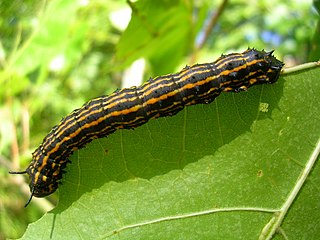
Anisota senatoria, the orangestriped oakworm, is a Nearctic moth of the family Saturniidae and subfamily Ceratocampinae. It is one of the more common Saturniids, reaching pest status occasionally in the northern parts of its range. As they are late-season feeders, however, they do little lasting damage to their hosts. It is very similar to A. finlaysoni in southern Ontario and A. peigleri in the southern US. The species was first described by James Edward Smith in 1797.
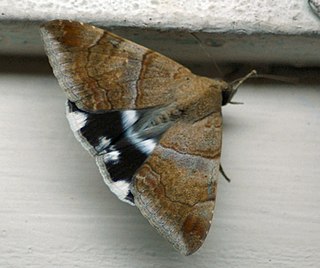
Achaea janata, the castor semi-looper or croton caterpillar, is an erebid moth, the caterpillars of which are termed 'semi-loopers' due to their mode of locomotion. It is found from the Indo-Australian tropics and subtropics, extending south to New Zealand and east through the Pacific archipelagoes to Easter Island. It is a major pest of castor throughout the world.

Acronicta euphorbiae, the sweet gale moth, is a moth of the family Noctuidae. The species was first described by Michael Denis and Ignaz Schiffermüller in 1775.
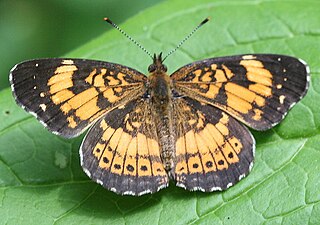
Chlosyne nycteis, the silvery checkerspot, is a species of Nymphalinae butterfly that occurs in North America. It is listed as a species of special concern and believed extirpated in the US state of Connecticut.

Megisto cymela, the little wood satyr, is a butterfly species of the Satyrinae family that occurs in North America.

Mythimna separata, the northern armyworm, oriental armyworm or rice ear-cutting caterpillar, is a moth of the family Noctuidae. It is found in China, Japan, South-east Asia, India, eastern Australia, New Zealand, and some Pacific islands. It is one of the major pests of maize in Asia. The species was first described by Francis Walker in 1865.
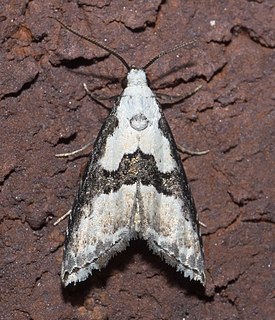
Nigetia is a monotypic moth genus in the family Erebidae. Its only species, Nigetia formosalis, the thin-winged algibelle or thin-winged owlet moth, has a scattered distribution in eastern North America from Ontario to Connecticut, south to Florida and Texas. Both the genus and the species were first described by Francis Walker in 1866.

Didymoctenia is a monotypic moth genus in the family Geometridae and subfamily Ennominae which was described by Warren in 1901. Its only species, Didymoctenia exsuperata, the thick-lined bark moth, was first described by Francis Walker in 1860. It is found in Australia.
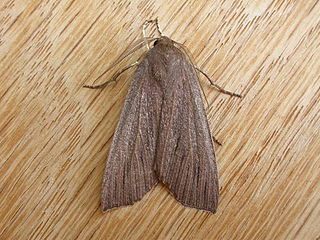
Palleopa is a monotypic moth genus in the family Geometridae. Its only species, Palleopa innotata, the finely-streaked crest-moth, is known from Australia, including Tasmania. Both the genus and species were first described by Francis Walker in 1866.

Symmacra is a monotypic moth genus in the family Geometridae described by Warren in 1896. Its only species, Symmacra solidaria, was first described by Achille Guenée in 1858. It is found in Indo-Australian tropics of India, Sri Lanka, Borneo east to Fiji, Samoa and Australia.

Eudocima materna, the dot-underwing moth, is a moth of the family Erebidae found in widespread parts of the world, mainly in tropical Asia extending to New Guinea and Australia as well as in Africa. Reports from the United States, Canada and the French Antilles are now considered to be Eudocima apta. The species can be differentiated from other Eudocima moths by the presence of small central black dot in each hindwing. The species was first described by Carl Linnaeus in his 1767 12th edition of Systema Naturae.

Idia rotundalis, the chocolate idia or rotund idia moth, is a litter moth of the family Erebidae. The species was first described by Francis Walker in 1866. It is found from southern Canada to Florida and Texas.
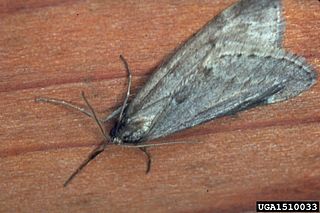
Alsophila pometaria, the fall cankerworm, is a moth of the family Geometridae. The species was first described by Thaddeus William Harris in 1841. It is found in North America from Nova Scotia west to Alberta, south to Colorado and California.

Homona coffearia, the tea tortrix or camellia tortrix, is a moth of the family Tortricidae. The species was first described by Nietner in 1861. It is widely distributed in the Oriental region.

Timandra comptaria is a moth of the family Geometridae first described by Francis Walker in 1862. It is found in Sri Lanka, Japan and Taiwan.























